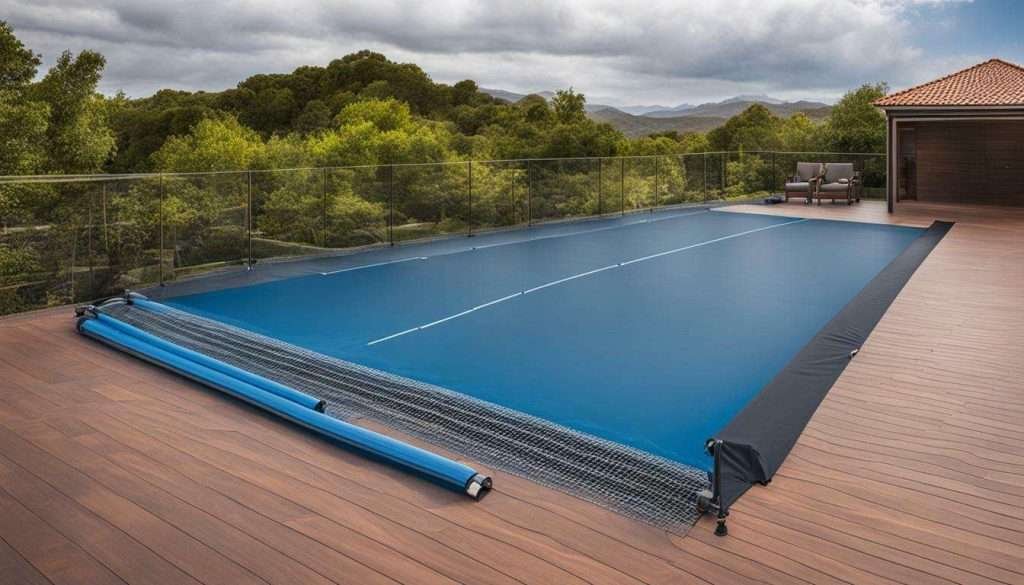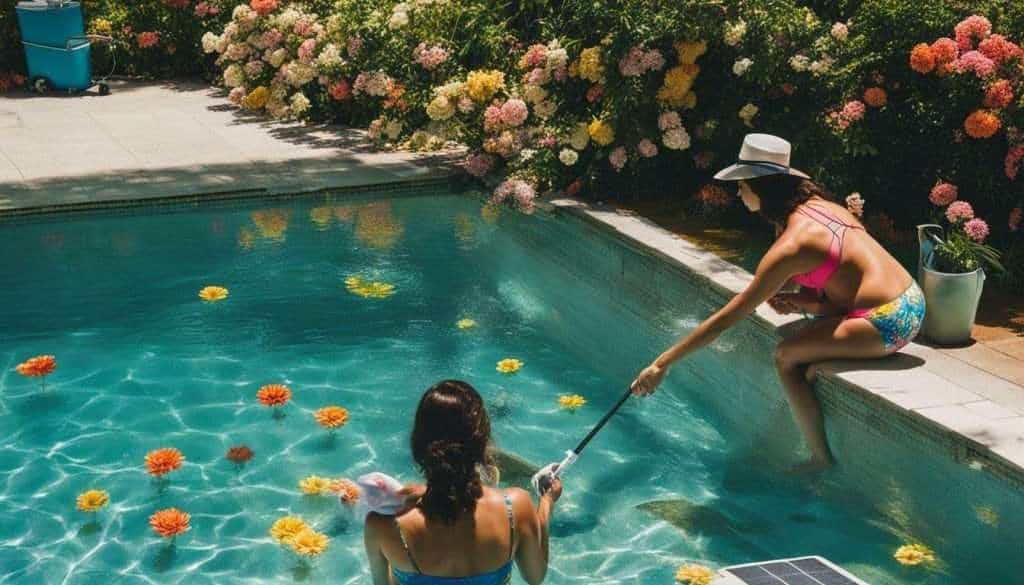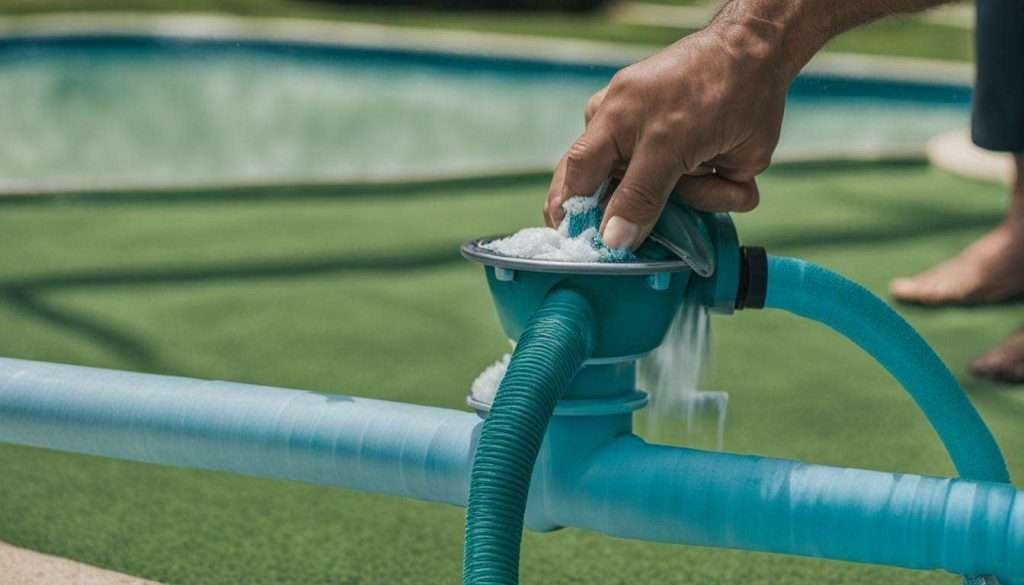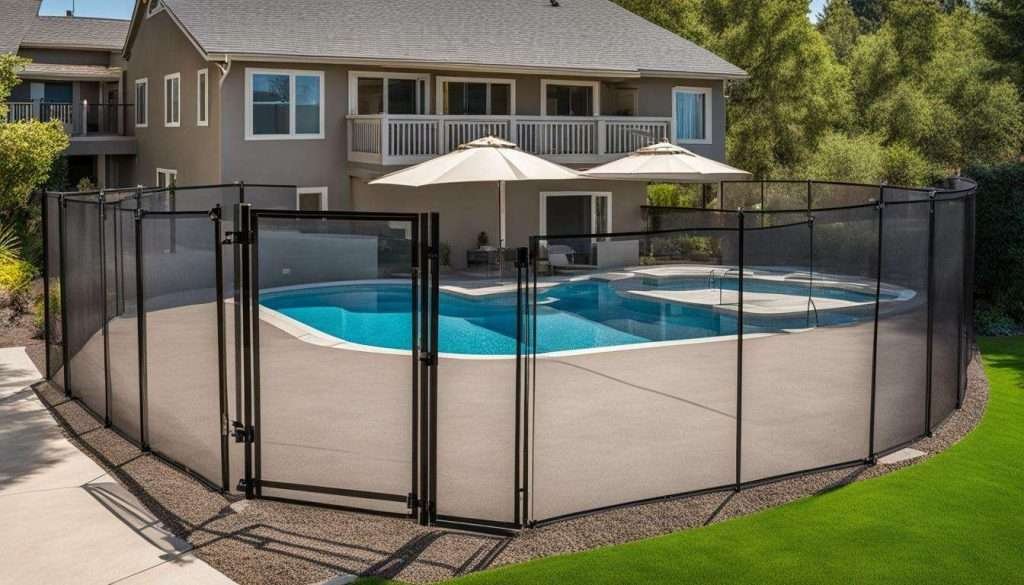If you’re a pool owner in South Africa, it’s essential to follow these guidelines for opening your pool in spring to ensure optimal safety and cleanliness. With the arrival of warmer weather, it’s time to prepare your pool for the upcoming summer season. Proper maintenance and safety measures are crucial for a clean and enjoyable swimming experience.
Key Takeaways:
- Follow the guidelines for opening your pool in spring to ensure safety and cleanliness.
- Comply with legal requirements by installing a fence at least 1.2m high and a self-locking gate.
- Install depth markers and a disclaimer board to enhance pool safety.
- Perform daily cleaning routines, including clearing out the basket and removing debris.
- Use a pool cleaner to remove algae and regularly backwash the filter.
Safety Measures for Opening Your Pool
Prioritizing safety is crucial when opening your pool for spring in South Africa, as it not only protects your loved ones but also ensures compliance with legal requirements. According to the National Building Regulations and SANS 10400, pools need to be protected with a fence at least 1.2m high and a self-locking gate. Installing a child-proof fence is an effective way to restrict access and reduce the risk of accidents. Additionally, consider using a safety net or solid safety cover to provide an extra layer of protection when the pool is not in use.

Depth markers and a disclaimer board should also be installed to provide clear information about the pool’s depth and any potential risks. These visual indicators help swimmers understand the depth of the water and ensure safe diving practices. Moreover, walls or fences surrounding the pool should be at least 1.2m tall and designed to make it difficult for children to climb or open. By implementing these safety measures, you can create a secure swimming environment for your family and guests.
Responsible supervision and emergency contacts
Alongside physical safety measures, responsible supervision is essential when the pool is in use. Always designate a responsible adult to supervise swimmers, especially young children, while they are in or near the pool. This person should remain vigilant and ensure that everyone follows safety guidelines. Additionally, it is crucial to have emergency contact numbers readily available in case of an accident. Keep a list of emergency contacts near the pool area and ensure that all family members are aware of these numbers.
Regular maintenance for a safe pool
Maintaining your pool regularly is also key to ensuring safety. Conduct daily cleaning routines, such as removing debris and clearing out the basket, to maintain a clean and hygienic swimming environment. Use a pool cleaner to remove algae and other impurities that can make the water unsafe for swimming. Regularly backwashing the pool filter is necessary to optimize its performance and prevent clogging.
In conclusion, opening your pool for spring in South Africa requires prioritizing safety. By following legal requirements, installing safety measures, practicing responsible supervision, and performing regular maintenance tasks, you can create a safe and enjoyable swimming environment for everyone. Remember, safety should always be the top priority when it comes to pool ownership.
Regular Maintenance Tasks for Spring Pool Care
To maintain optimal pool conditions, follow these regular maintenance tasks specifically designed for spring pool care in South Africa.
Daily Cleaning Routine
Start your spring pool care routine by establishing a daily cleaning routine. Remove any debris, such as leaves and twigs, from the surface of the water using a skimmer net. Also, clear out the basket in the skimmer to prevent clogs and ensure proper water flow. Regularly brush the pool walls and floor to dislodge any dirt or algae buildup and vacuum the pool to remove any remaining debris.
Using a Pool Cleaner
To effectively combat algae growth and maintain crystal clear water, consider using a pool cleaner specifically designed for spring pool care. These devices automatically move around the pool, scrubbing the walls and floor and collecting debris in a built-in bag or filter. By using a pool cleaner, you can minimize manual cleaning and ensure a consistently clean pool throughout the spring season.
Regular Filter Backwashing
A crucial part of spring pool maintenance is regular backwashing of the filter. This process removes trapped debris and contaminants, allowing the filter to operate efficiently and maintain proper water circulation. Follow the manufacturer’s instructions for your specific filter type to ensure proper backwashing frequency and procedure. Regular filter maintenance will help keep your pool water clear, clean, and ready for swimming.

| Monthly Maintenance Tasks | Quarterly Maintenance Tasks |
|---|---|
|
|
In South Africa, it is important to adhere to the guidelines set out in the National Building Regulations and SANS 10400. These regulations stipulate that pools must be protected with a fence at least 1.2m high and a self-locking gate. Additionally, depth markers and a disclaimer board should be installed to ensure the safety of all pool users.
Pool Water Balancing and Chemical Levels
Achieving and maintaining the right chemical balance in your pool water is essential for optimal swimming conditions during the spring season in South Africa. Proper pool water balancing helps to prevent the growth of algae and bacteria, ensuring that the water is safe and clean for you and your family to enjoy. In addition, balanced water also protects your pool equipment, such as the pump and filter, from damage caused by corrosive or scale-forming water.
When it comes to pool water balancing, there are a few key factors to consider. These include pH levels, alkalinity, and sanitizer levels. pH measures the acidity or alkalinity of the water, and maintaining a pH level between 7.2 and 7.6 is ideal. Alkalinity acts as a buffer for the pH, and it should be kept within the range of 80-120 ppm (parts per million). Sanitizer levels, typically chlorine or bromine, help to kill bacteria and keep the water clean. It is recommended to maintain a chlorine level between 1-3 ppm.
To test and adjust the chemical levels in your pool water, you will need a reliable pool water testing kit. Regular testing is important, especially during the spring season when the changing weather conditions and increased pool usage can affect the water balance. Test the water at least once a week, and adjust the chemicals accordingly to ensure proper balance.
Remember, always follow the manufacturer’s instructions when adding chemicals to your pool water. It is also important to keep in mind that maintaining proper water balance is an ongoing process, and it may require regular adjustments throughout the spring season. By investing time and effort into pool water balancing, you can enjoy a crystal clear and inviting swimming pool all spring long.
Table: Recommended Pool Chemical Levels
| Chemical | Minimum Level | Maximum Level |
|---|---|---|
| pH | 7.2 | 7.6 |
| Alkalinity (ppm) | 80 | 120 |
| Chlorine (ppm) | 1 | 3 |
Equipment Maintenance for Long-Term Pool Care
Ongoing equipment maintenance is key to ensuring the longevity and efficient functioning of your pool, especially during the spring season in South Africa. Regular checks and maintenance tasks should be performed to keep your pool equipment in optimal condition. Here we outline the essential maintenance steps to follow. Additionally, pay special attention to the pool filter and pump, as these components play a crucial role in circulating water and maintaining clarity. Implementing effective pool maintenance for summer will ensure that your pool is ready for peak use during the warmer months. Don’t forget to check water chemistry regularly to prevent algae growth and ensure a safe swimming environment. In addition to routine checks, it’s crucial to develop a schedule for yearly pool maintenance tasks in SA to address any wear and tear effectively. This proactive approach will help prevent potential issues and ensure that all components, from pumps to filters, operate at peak efficiency. By adhering to these maintenance steps, you can enjoy a clean, safe, and well-functioning pool throughout the season.
1. Pump Impellor Inspection
Check the pump impellor for any signs of damage or clogging. Remove any debris that may have accumulated and ensure that the impellor is spinning freely. A properly functioning impellor is crucial for the circulation and filtration of water in your pool.
2. Water Level Monitoring
Regularly monitor the water level in your pool to detect any leaks or evaporation issues. Maintaining the correct water level is important for the proper functioning of your pool equipment. If you notice a significant drop in water level, investigate and repair any leaks promptly to prevent further damage.
3. Manual Backwash of Sand Filter
The sand filter in your pool requires regular maintenance to keep it clean and efficient. Perform a manual backwash every six months, or as needed, to remove any trapped debris and ensure optimal filtration. Follow the manufacturer’s instructions for your specific sand filter model.
4. Equipment Lubrication
Apply lubrication to the O-rings and gaskets of your pool equipment to prevent friction and ensure smooth operation. Regularly inspect and replace any worn-out or damaged O-rings to prevent leaks and maintain the integrity of your equipment.
| Equipment | Maintenance Frequency |
|---|---|
| Pump and Motor | Annual inspection and maintenance as needed |
| Filter System | Regular backwashing and manual cleaning as needed |
| Heater | Annual inspection and maintenance as needed |
| Automatic Pool Cleaner | Regular cleaning and maintenance as needed |
Remember, proper equipment maintenance is essential for the longevity and efficiency of your pool. By following these guidelines and performing regular checks, you can ensure that your pool equipment operates smoothly and your pool remains in excellent condition throughout the spring season and beyond.

Additional Safety Precautions for Pool Owners
In addition to legal requirements, there are additional safety precautions that South African pool owners should take to create a secure and accident-free pool environment. Ensuring the safety of your pool is of utmost importance, especially when it comes to protecting children and preventing accidents. Here are some essential safety measures to consider:
1. Install a Child-Proof Fence
According to the National Building Regulations and SANS 10400, pools must be protected by a fence at least 1.2m high. Install a child-proof fence around your pool area to prevent unauthorized access and keep children safe. Make sure the fence has a self-locking gate that is difficult for children to open. This will help prevent accidents and give you peace of mind.
2. Use a Safety Net or Solid Safety Cover
Adding an extra layer of protection to your pool is crucial. Consider installing a safety net or a solid safety cover. These safety features can help prevent accidental falls into the pool and keep the water secure when the pool is not in use. Make sure the net or cover is properly installed and secure to provide maximum safety.
3. Ensure Walls or Fences are Difficult to Climb
Make sure the walls or fences surrounding your pool are at least 1.2m tall and difficult for children to climb or bypass. Eliminate any potential footholds or handholds that could enable children to climb over the barrier. It is recommended to have smooth and vertical surfaces that discourage climbing to minimize the risk of accidents.
4. Practice Responsible Supervision and Emergency Preparedness
Always supervise children when they are near or in the pool, regardless of their swimming capabilities. Responsible supervision is the key to preventing accidents. Additionally, ensure that emergency contact numbers are readily available near the pool area. Knowing what to do in case of an emergency and having the necessary support are crucial for maintaining a safe pool environment.

Remember, creating a safe pool environment requires a combination of adherence to legal requirements and additional safety measures. By implementing these precautions, you can enjoy a worry-free pool experience while keeping your loved ones protected.
Conclusion
By following the guidelines and tips outlined in this article, South African pool owners can confidently open their pools for spring, knowing they have taken the necessary steps for optimal safety and cleanliness. Additionally, properly storing and handling household chemicals in pools is essential for maintaining a safe and clean swimming environment. It is important to carefully follow the manufacturer’s instructions when adding chemicals to the water, and to store them in a secure location away from children and pets. By taking these precautions, South African pool owners can enjoy a worry-free and refreshing swimming experience throughout the spring and summer months.
Safety is of utmost importance when it comes to opening your pool for the spring season. According to the National Building Regulations and SANS 10400, it is mandatory to protect your pool with a fence that is at least 1.2m high and features a self-locking gate. Additionally, depth markers and a disclaimer board should be installed to ensure proper safety awareness for all pool users.
Regular maintenance tasks are vital to keep your pool in pristine condition. Daily cleaning routines, such as removing debris and clearing out the basket, are necessary to prevent clogs and maintain water circulation. Using a pool cleaner to effectively remove algae and regular backwashing of the filter will further enhance water clarity. It is also important to check chemical levels weekly and perform a manual backwash of the sand filter every six months to maintain balanced water chemistry.
Long-term pool care requires attention to equipment maintenance. Yearly tasks, including checking the pump impellor for any issues and monitoring water levels for leaks, contribute to the overall function and longevity of your pool equipment. By prioritizing regular maintenance, you can address any potential problems early on and prevent costly repairs.
Lastly, additional safety precautions should be taken to ensure the well-being of pool users, especially children. Installing a child-proof fence and using a safety net or solid safety cover are crucial measures to prevent accidental drowning. The walls or fences surrounding the pool should be at least 1.2m tall and designed to be difficult for children to climb or open. Responsible supervision and providing emergency contacts are also essential for water safety.
Which Pool Covers Are Recommended for Protecting Your Pool during Spring?
When it comes to protecting your pool during spring, it’s essential to invest in the best pool covers in South Africa. These covers offer a crucial layer of defense against debris, leaves, and even harmful UV rays. With their durable materials and reliable designs, these pool covers ensure that your pool stays clean, safe, and well-maintained throughout the season. Safeguard your pool and enjoy worry-free swimming with the recommended pool covers.
FAQ
What are the legal requirements for pool safety in South Africa?
According to the National Building Regulations and SANS 10400, pools need to be protected with a fence at least 1.2m high and a self-locking gate. Depth markers and a disclaimer board should also be installed.
What are the daily maintenance tasks for spring pool care?
Daily maintenance tasks for spring pool care include removing debris and clearing out the basket. A pool cleaner should be used to remove algae, and regular backwashing of the filter is necessary.
How often should I check the chemical levels in my pool?
Chemical levels should be checked weekly to ensure proper water balance and safety.
What regular maintenance tasks should I perform for long-term pool care?
Regular maintenance tasks for long-term pool care include checking the pump impellor and monitoring water levels for leaks. A manual backwash of the sand filter is also needed every six months.
What are some additional safety precautions for pool owners?
Additional safety precautions for pool owners include installing a child-proof fence and a safety net or solid safety cover. Walls or fences should be at least 1.2m tall and difficult for children to climb or open.
Why is responsible supervision and emergency contacts crucial for water safety?
Responsible supervision and emergency contacts are crucial for water safety to ensure prompt action in case of an emergency and to prevent accidents or drowning incidents.


